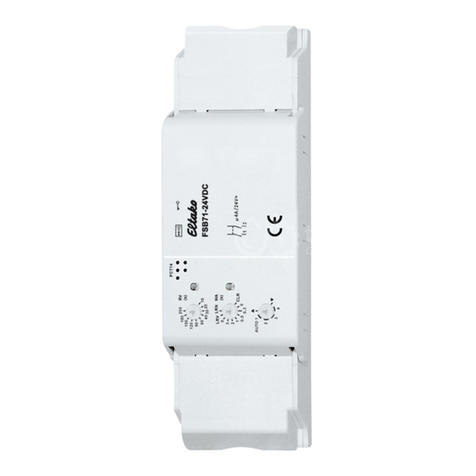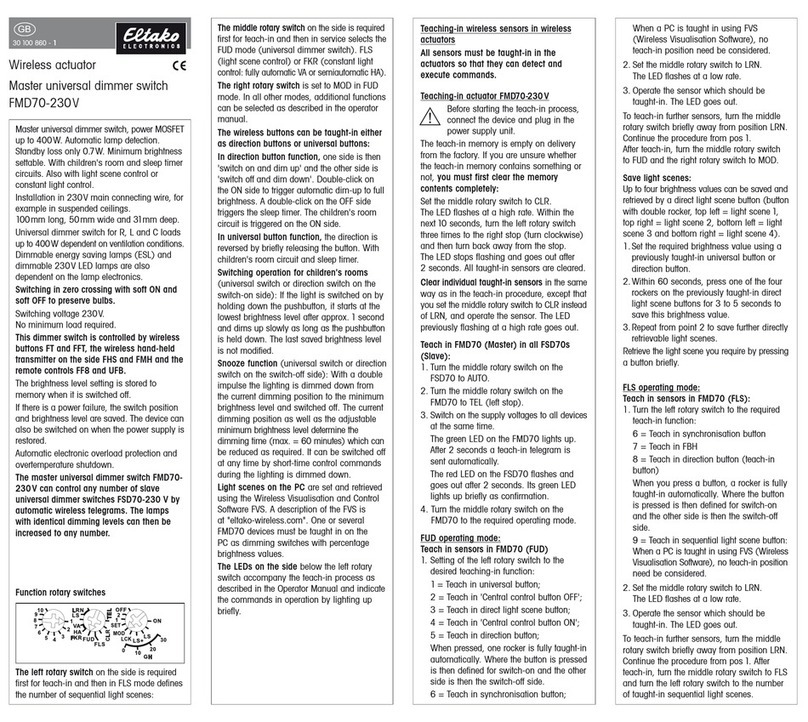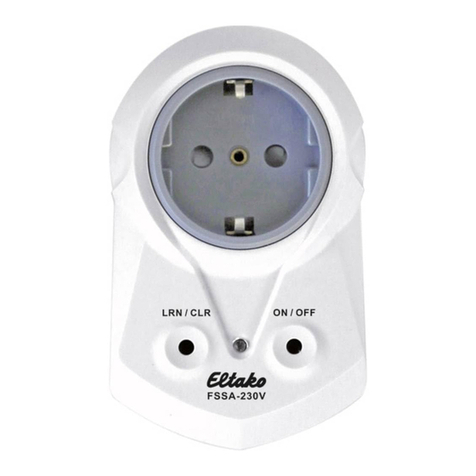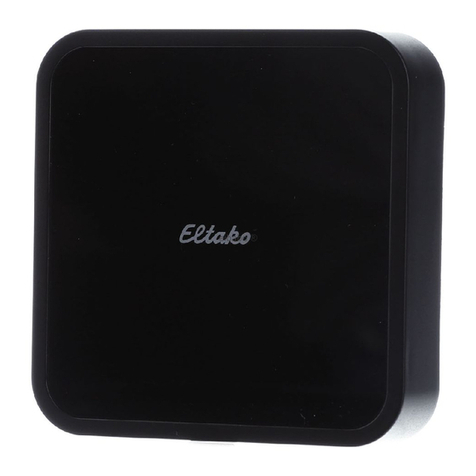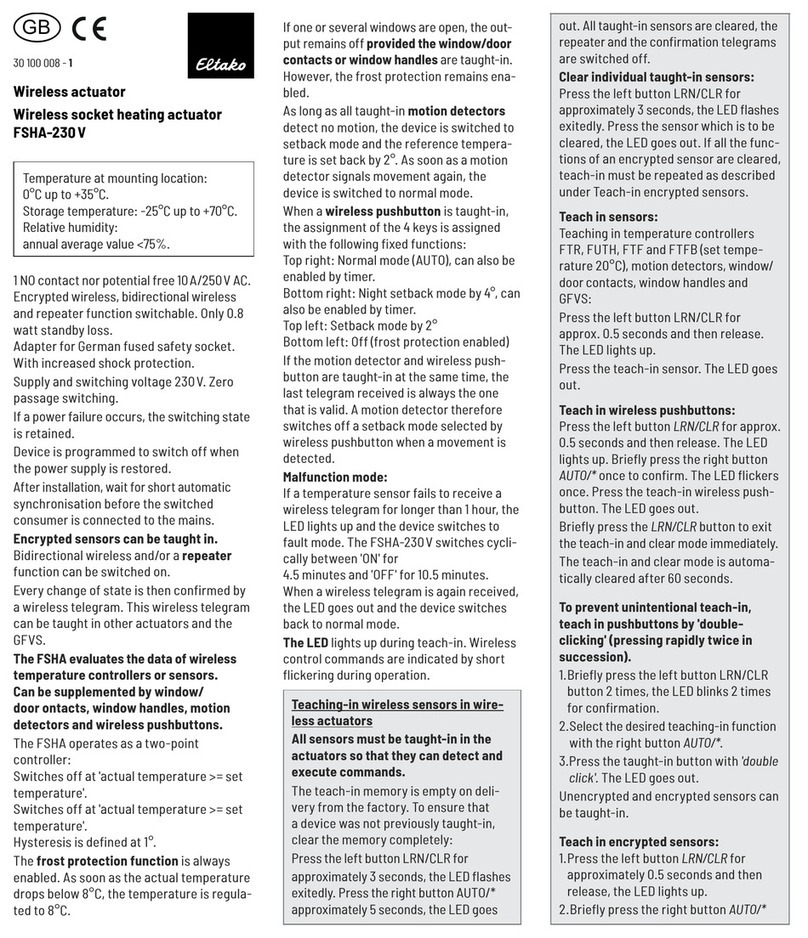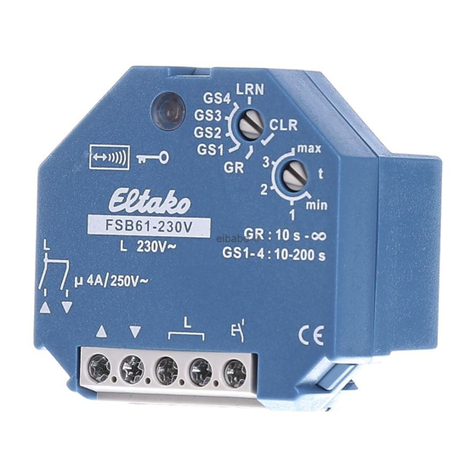
GB
30 400 868 - 3
Wireless actuator for shading
elements and roller shutters
FSB71-2x-230V
Switch actuator for shading elements
and roller shutters with 2 channels for
two 230V motors. 2+2 NO contact
4A/250V AC, not potential free. Encrypted
wireless, bidirectional wireless and
repeater function are switchable. Only
0.8 watt standby loss.
Mounting in the 230V power supply
cord, e.g. in false ceilings. 166mm long,
46mm wide and 31mm deep.
Zero passage switching to protect
contacts and motors.
A motor is connected to 1, 2 and N; a
second motor may be connected to 3, 4
and N.
If supply voltage fails, the device is
switched off in defined mode.
The pushbuttons can be taught-in either
as direction pushbuttons or universal
pushbuttons:
Local control with universal pushbuttons:
With each impulse the switch position
changes in the sequence 'Up, stop, Down,
Stop'.
Local control with direction pushbutton:
A top impulse by pushbutton directly
activates the 'UP' switch position.
A bottom impulse by pushbutton directly
activates the 'DOWN' switch position.
A further impulse from one of the two
pushbuttons stops the sequence imme-
diately.
Only skilled electricians may install
this electrical equipment otherwise
there is the risk of fire or electric
shock!
Temperature at mounting location:
-20°C up to +50°C.
Storage temperature: -25°C up to +70°C.
Relative humidity:
annual average value <75%.
valid for devices from production week
46/15 (see bottom side of housing)
Central control dynamic without priority:
A control signal from a pushbutton
which was taught-in as a central control
pushbutton without priority directly acti-
vates the switch position 'Up' with a
scanning pulse up and the switch position
'Down' with a scanning pulse down.
Without priority because this function can
be overridden by other control signals.
Central control dynamic with priority:
A control signal of min. 2 seconds from
a pushbutton which was taught-in as a
central control pushbutton with priority
directly activates the switch position 'Up'
(press top) and the switch position
'Down' (press bottom). With priority
because these control signals cannot be
overridden by other (local) control signals
until the central control signal is can-
celled by pressing again the central con-
trol pushbutton 'Up' or 'Down'.
The switch position 'up' or 'down' and
the priority are specifically activated with
a control signal, e.g. from a FSM61
taught-in with priority as a central push-
button. With priority because these con-
trol signals cannot be overridden by
other control signals until the central
command is cancelled by the termination
of the control signal.
Shading scene control: Up to 4 already
stored 'Down' runtimes can be called
using the control signal of a pushbutton
with double rocker taught-in as a scene
pushbutton or automatically using an
additional taught-in FAH60 wireless
exterior brightness sensor.
If this was not the last function of the two
channels anyway, the shutter is moved
until the end of the RV delay time for 'Up'
set in the top rotary switch to ensure a
safe starting position. The device then
switches over automatically to 'Down'
and stops on expiry of the saved time. If
a turning time is set for blinds, this is
used to turn the blinds.
A move command is only started for the
first time for scenes with RV time (fully
'Up' or 'Down').
If a wireless outdoor brightness sensor
FAH60 is also taught-in in addition to a
scene pushbutton, the taught-in scenes
1, 2 and 4 are executed automatically
depending on the outdoor brightness:
Scene 1 in direct sunlight (>25KLux),
Scene 2 in daylight (300Lux to 25KLux)
and Scene 4 in darkness (<50Lux).
During the first teach-in, therefore, a scene
pushbutton is assigned automatically to
Scenes 1 = no function, 2 = raise fully
and 4 = lower fully. Scene 1 must be
taught-in separately if the FAH60 is to
trigger a shading system when direct
sunlight is detected. A taught-in Scene 3
is only retrievable by means of a scene
pushbutton.
Scenes 2 and 4 can be changed sepa-
rately at any time. However, this is not
advisable if the right rocker is pro-
grammed to be used as a normal up/
down shutter pushbutton or an FAH60
was taught-in.
FAH60 wireless telegrams for Scenes 1 =
direct sunlight are executed immediately
and 4 = darkness. Three telegrams are
required for Scene 2 = daylight in order to
mask out interference lights. To prevent
'nervous' opening and closing of a
shading element when there is rapid
fluctuation between darkness and bright-
ness, changing FAH60 wireless tele-
grams are only executed every 2 minutes.
The automatic systems can be cancelled
or overridden at any time by confirming
any one of the taught-in pushbuttons.
Central pushbuttons always have priority
When controlled via the GFVS software,
Up and Down move commands can be
started at the precise move time specified.
Since the actuator reports back the precise
time moved after each action, even when
the movement is triggered by pushbutton,
the position of the sunshading is always
correctly displayed in the GFVS software.
When the top or bottom end position is
reached, the position is automatically
synchronised.
Encrypted sensors can be taught in.
You can switch on bidirectional wire-
less and/or a repeater function.
Every change in state and incoming
central command telegrams are con-
firmed by a wireless telegram. This wire-
less telegram can be taught-in in other
actuators, in universal displays FUA55
and in the GFVS software.
